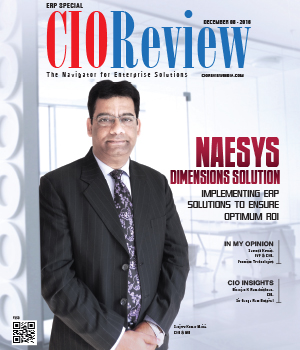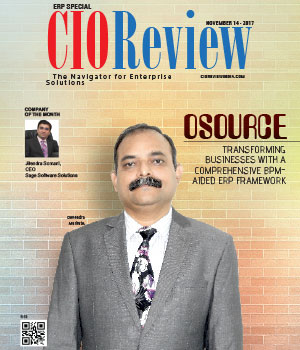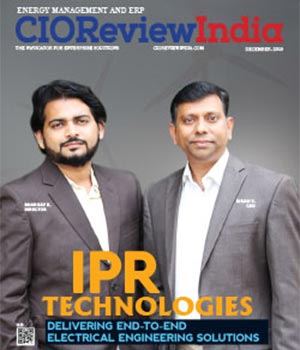Rejuvenating ERP with Internet of Things
Chandran R, CIO, Bahwan Cybertek | Tuesday, 24 May 2016, 09:22 IST
 In today’s connected world, Social, Mobile, and Cloud technologies are key enablers for organizations to sustain and to retain leadership position. This is truer in consumer-centric interaction models. Today’s product and service managers have to watch product and customer behavior closely in real-time owing to the reach of technology.
In today’s connected world, Social, Mobile, and Cloud technologies are key enablers for organizations to sustain and to retain leadership position. This is truer in consumer-centric interaction models. Today’s product and service managers have to watch product and customer behavior closely in real-time owing to the reach of technology.
Most of us have heard about Internet of things (IoT)- the technology that connects sensors, people and processes to enable things to exchange data. IoT can bring about a significant positive impact on the performance of an enterprise by increasing operational efficiency and by reducing operating costs. IoT, in essence, allows ERP systems to connect with People, Processes, Data, and Things in an intelligent way, to enable new business models and to make better business decisions rather than a transaction-oriented approach.
Accordingly, the way manufactures track product performance has been changing due to the deployment of sensors in a wide spectrum of objects, from coffee makers to cars. This, in turn, would require ERP systems to interact with such devices/sensors that are out in the field and in remote locations, for ordering, shipping, and repairing (with necessary validations / data filtering techniques). The new generation of well-informed ERP systems must be able to process data in real or near real-time scenarios across a cloud infrastructure.
Organizations across the world have been using Machine-to-Machine (M2M) communications to collect data by attaching sensors, largely using proprietary systems. For example, the oil upstream enterprises that deal with high-value assets monitor rigs in real-time because they understand the direct benefit of monitoring leading to reduction in idle-time which has a direct impact on their bottom-line.
The following is a partial list of enterprise business functions that require seamless integration of sensors/ devices with ERP applications.
• Plant to Enterprise (P2E) Integration
Production, batch information and energy consumption data from the plant equipment can be integrated, in real-time, with ERP applications.
• Asset Health Monitoring
Equipment can be monitored for effects of environmental and operational conditions to prevent unforeseen machine failures. Also equipment usage, such as run hours, fuel usage etc., can be monitored in real-time, to determine the need for proactive maintenance and integration with the asset management module of ERP. Subsequently, the maintenance module of ERP can send real-time alerts based on an analysis of the data received.
• Remote Diagnostics
Products / machines that contain sensors / on-board agents can communicate back to the maintenance division about the current status, diagnostic information etc., for better quality of service to customers. This is achieved by capturing potential failures before they make an impact and also by increasing revenue, through expanded service offerings and replenishment of consumables and spares.
• Inventory Management
Understandably, Inventory management can be easily handled through IoT. As an example, sensors can check inventory levels, by weight, volume or number of items, and trigger replenishment transactions. Not only is this possible in manufacturing but is also so in retail – the use of sensors for inventory management and integration to ERP in vending machines has been gaining traction. Deployment of RFID (Radio-frequency Identification) has matured across several industries. Vehicle tracking done using GIS (Geographic Information System) and IoT, adding value to the entire supply chain management, is a case in point.
• Product Quality
Quality monitoring is another process that can significantly benefit from sensor-ERP integration. Data acquisition from equipment or component test beds in real-time would provide insights into parameter deviations and trigger necessary corrective actions.
Conclusion
IoT requires change in the way organizations do business. The devices and sensors used in the IoT applications generate huge volumes of data that need to be systematically collected, processed and analyzed. Most of the data might not be of any use to ERP applications. Hence a device gateway with local intelligence, to filter and forward the data that is required by ERP applications, is needed for all event and transaction processing. This would require careful planning and design.
Organizations would have to define a lucid IoT roadmap and evaluate ERP integration options, arriving at enterprise architecture, to sense and acquire data, in order to take informed decisions, of course, considering necessary data security and privacy aspects of device communications. Conceivably, some of the OEM software vendors have already defined their respective roadmaps for integration of ERP and IoT.
In essence, unprecedented innovative business models can evolve with the right blend of IoT, Social Media, Mobility and Enterprise Applications Integration, offering a renewed and rejuvenated customer experience.
CIO Viewpoint
ERP Systems Evolving to Improve Business Agility
By Abhrasnata Das
Transforming Manufacturing by Creating a...
By Thiagarajan N, Director IT at IMI Critical Engineering
How Reliance Entertainment leverages SMAC and...
By Sayed Peerzade, Group CIO, Reliance Big Entertainment & Reliance Entertainment - Digital
CXO Insights
Hit Reset with Technology as the Trusted Advisor
By Guruprasad Gaonkar, APAC SaaS Leader - Office of Finance (ERP) & Digital Supply Chain, Oracle
ERP Implementation: The Pitfalls to Avoid
By By Navjot Singh Sidana, General Manager – ERP, Delhi Integrated Multi-Modal Transit System (DIMTS) Ltd.
Power And Water Nexus Central To Data Center...




.jpg)





